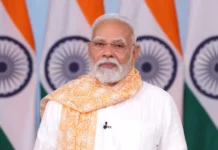
Yoga is a deep spiritual system of attaining ultimate union with the divine, a journey into ancient India’s history!
Purnima Nath
Although Yoga has become a global symbol of physical exercise and perfect body in the mainstream today, it is far greater than asanas (postures). In today’s temporary-body-centric world, yoga lost its original form of deep spiritual significance. Yoga is the union of finite to the infinite, connection of manifest to hidden, integration and harmony between thoughts, feelings, words, and deeds; and total balance of mind, body, and spirit; uniting individual soul to the divine soul to achieve utmost stability and state of enlightenment through physical, mental, intellectual, and spiritual awakening. Yoga is pure science and a sophisticated and comprehensive eastern system of developing a person’s Chetana (consciousness).
But how yoga got launched in the western world? On this International Yoga Day, we will establish facts of interrelatedness of Hinduism to yoga. We will further look at some examples of how the western world is refusing its origin and dismissing its contribution, and pushing a negative connotation of Hindu affiliation and association with India.
Yoga and Hinduism:
‘Yoga’ comes from a Sanskrit word – ‘yuj’, meaning ‘to join’, ‘to yoke’, ‘to subjugate’, ‘to connect’, or ‘to unite’. To understand the origin of yoga, we must dig into the history of Hinduism.
Hinduism comes from the Vedic tradition of Sanatana Dharma, the eternal truth. The concept of ‘eternal existence’ derives from the soul. Our soul might leave our body at a certain point in our lifetime (the event is called death) however; the soul lives on – an extremely important ideology to note here. Hindu belief system revolves around the emphasis of Karma (deeds). The idea of morality that drives our deeds becomes even more critical for the Hindu belief system. Meaning, our karma accumulates ‘memories’ and transfers from birth, to rebirth and reincarnation. An individual soul’s optimum goal is to attain moksha (mukti, liberation, salvation, release, emancipation, enlightenment) from the pain and sufferings caused by the cycle of birth, death, and rebirth. Our body is the only vehicle for attaining moksha. Hence, our thoughts, words, deeds, and actions must all be aligned. In that context, yoga is the technique, science and art of achieving the pinnacle of alignment of mind, body, and spirit.
Origin of yoga:
It is said that Lord Shiva, the destroyer of worlds, is the supreme first yogic guru, known as the Adiyogi, the source of yoga. Hinduism (Sanatana Dharma) is older than 5000+ years. We certainly can connect Yoga to 5000 years old Indus valley civilizational evidence. A famous clay seal excavated where a yogi is seated on lotus posture of meditation (3500 – 1700 BCE Mahenjo-Daro and Harappan civilization of Indus Valley). I have articulated more information on the connection on Hindus, Hinduism and Hindu Indus civilization in a previous article.
It is believed that Rig Veda was written by Rishi Vyasa somewhere in between 1750 – 1500 BCE. This is the oldest sacred text of the world, and written mantras, hymns, meditations, and pranayama mentions about yoga. Note that, our ancestors preserved ancient wisdom of hymns (a group of poems from the Rig Veda), literature, and the learning, orally passed on through the many generations. Therefore, it is safe to say that, yogic practices were prevalent even before Rig Veda was written. Upanishad also mentioned yoga (1500 – 1100 BCE). Rishi Patanjali is the father of Yoga. Although he is not the inventor of yogic practices, he certainly is the one who gathered all the knowledge under “Yoga Sutras” (500 – 200 BCE), as the definitive guide to Yogic wisdom. Our ‘itihasa’ (history) books, such as Ramayana, Mahabharata, and Bhagavad Geeta (The Holy book of the Hindus) were written between 800 – 400 BCE. Three types of yoga are mentioned in Bhagavat Geeta: Karma – Deeds, Jnana – Knowledge, and Bhakti – Devotional. 
In 2017, scientists discovered a NASA satellite image that showed the floating manmade bridge with 7000 years old rocks placed on 4000 years old sand between India and Sri Lanka. Archeological/geological/oceanographic evidence of this ancient 30 miles long magical Ram Sethu (Adam’s bridge) is located between India and Sri Lanka, a report released by Science Channel, USA, proving Indian text of Ramayana was not a myth. Archaeological evidence of sunken ancient city of Dwaraka, [founded by Lord Krishna, mentioned in the longest epic of Mahabharata, 3182 – 3138 BCE], currently known as the Devabhoomi (Land of the Lord) in Gujarat’s west coast is best-studied underwater sites in India.
A visual representation of the timeline of world religions, Vedic texts, and Indian scriptures should help us draw a link between the evidential details of Hinduism, Vedic culture, and origin of yoga and its undeniable continuity.
Why does the West deny the origins of yoga to Hinduism and insult its roots?
Sadly though, I also have witnessed many degrading comments lately, downplaying direct interconnectedness of Yoga to Hinduism, Hindu tradition, and India. Yoga and meditation are also practiced in other India-originated religions such as Buddhism. Yoga is not just merely a random collection of postures; it has a deeper spiritual meaning associated.
In the Hindu tradition, a teacher is someone with substance, knowledge, and deep wisdom, who is equipped to guide the disciples. For the largest part, we are witnessing an awful trend where western scholars and entrepreneurs would grab the ancient Indian culture, practice, tradition; and patent it in the west and earn money from certain ideas that are not theirs. For instance, turmeric. Lack of respect, honesty, and ethics are hypocritical. Hindu Sanatana Dharma is the only continuous living civilization that has survived, unlike the Aztecs or the Mayans. Despite the merciless and harsh history of invasion and atrocities caused by foreign invaders, and 1000s of years of ruling on the native Indians, India remains the lone country that was not converted into a foreign religion, like Iran, Syria, Libya, Somalia, and so on.
How yoga came to the west?
Modern-day influential Indian monk Swami Vivekananda introduced yoga to the western world, especially to America in 1893. His famous speech at Chicago in the parliament of world religion captured the world’s eye and created a stir in the west. Magnanimous portrayal and powerful oration of spiritual superiority of Indian religious traditions won many hearts. He spoke about the world’s religion of various paths but phases of one eternal religion. Although the spiritual essence of yoga is diluted, today, and it is heavily commercialized in the west as mere physical practice and postures, the benefits of yoga are still boundless. Stress reduction, blood pressure control, focus and concentration, reduced rate of aging, centeredness and gentleness, patience, sharp intuition, and improved creativity, are just a few positive health benefits of yoga. It is practiced by millions of westerners currently.
The 8 limbs of yoga are Yama (restraints), Niyama (self observances), Asanas (postures), Pranayama (breath control), Pratyahara (withdrawal of the senses), Dharana (concentration), Dhyana (meditation), and Samadhi (Self-realization). And balancing the 7-chakras namely, Muladhara (Root chakra), Syadhisthana (Sacral chakra), Manipura (Solar Plexus Chakra), Anahata (Heart chakra), Vishuddha (Throat chakra), Ajna (Third eye chakra), and Sahasrara (Crown chakra) through meditation is supremely beneficial for aligning mind and body.
 On the 69th session of UN General assembly address on Sept 9th, 2014, India’s Prime Minister Narendra Modi suggested the date of 21 June for International Yoga Day, as it is the longest day of the year in the Northern Hemisphere and shares a special significance in many parts of the world. June 21st, 2015 was celebrated the first International Yoga Day in the entire world.
On the 69th session of UN General assembly address on Sept 9th, 2014, India’s Prime Minister Narendra Modi suggested the date of 21 June for International Yoga Day, as it is the longest day of the year in the Northern Hemisphere and shares a special significance in many parts of the world. June 21st, 2015 was celebrated the first International Yoga Day in the entire world.
IN CONCLUSION:
Yoga is the process of complete constancy of the mind. Yoga’s benefits are immeasurable, extensive, and undeniable. The best part is anyone can attain these benefits. On this International Yoga Day, we must also revive its root, especially the spiritual purpose of yoga to the union of mind, body and soul, and its deep relationship and profound ties to Hinduism, Hindu traditions, Vedic scriptures and Hindustan (India / Bharat). A clear timeline of historic events established the factual evidence behind all arguments. There should be no doubt about its origin, its connections, and its purpose. Furthermore, deliberate attempts and constant efforts of diluting its connection to Hinduism or India only exposes fruitless propaganda.






